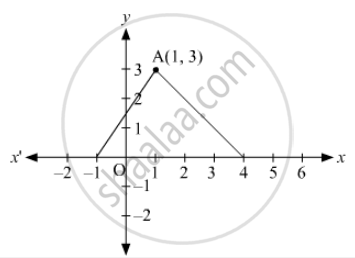Advertisements
Advertisements
प्रश्न
Prove that the points (4, 5) (7, 6), (6, 3) (3, 2) are the vertices of a parallelogram. Is it a rectangle.
उत्तर
Let A (4, 5); B (7, 6); C (6, 3) and D (3, 2) be the vertices of a quadrilateral. We have to prove that the quadrilateral ABCD is a parallelogram.
We should proceed with the fact that if the diagonals of a quadrilateral bisect each other than the quadrilateral is a parallelogram.
Now to find the mid-point P(x,y) of two points `A(x_1, y_1)` and `B(x_2,y_2)` we use section formula as,
`P(x,y) = ((x_1 + x_2)/2, (y_1 + y_2)/2)`
So the mid-point of the diagonal AC is,
`Q(x,y) = ((4 + 6)/2, (5 + 3)/2)`
= (5,4)
Therefore the mid-points of the diagonals are coinciding and thus diagonal bisects each other.
Hence ABCD is a parallelogram.
Now to check if ABCD is a rectangle, we should check the diagonal length.
`AC = sqrt((6 - 4)^2 + (3 - 5)^2)`
`= sqrt(4 + )4`
`= 2sqrt2`
Similarly,
`BD = sqrt((7 - 3)^2 + (6 - 2)^2)`
`= sqrt(16 + 16)`
`= 4sqrt2`
Diagonals are of different lengths.
Hence ABCD is not a rectangle.
APPEARS IN
संबंधित प्रश्न
A line intersects the y-axis and x-axis at the points P and Q respectively. If (2, –5) is the mid-point of PQ, then find the coordinates of P and Q.
Find the value of k, if the point P (0, 2) is equidistant from (3, k) and (k, 5).
Name the quadrilateral formed, if any, by the following points, and given reasons for your answers:
A(-3, 5) B(3, 1), C (0, 3), D(-1, -4)
Find the points of trisection of the line segment joining the points:
5, −6 and (−7, 5),
Find the coordinates of the midpoints of the line segment joining
A(3,0) and B(-5, 4)
Find the ratio in which the line segment joining the points A(3, 8) and B(–9, 3) is divided by the Y– axis.
Find the coordinates of the circumcentre of a triangle whose vertices are (–3, 1), (0, –2) and (1, 3).
If `P(a/2,4)`is the mid-point of the line-segment joining the points A (−6, 5) and B(−2, 3), then the value of a is
The area of the triangle formed by the points A(2,0) B(6,0) and C(4,6) is
If the point \[C \left( - 1, 2 \right)\] divides internally the line segment joining the points A (2, 5) and B( x, y ) in the ratio 3 : 4 , find the value of x2 + y2 .
Find the value of k if points A(k, 3), B(6, −2) and C(−3, 4) are collinear.
If the points A(−1, −4), B(b, c) and C(5, −1) are collinear and 2b + c = 4, find the values of b and c.
If the points A(−2, 1), B(a, b) and C(4, −1) ae collinear and a − b = 1, find the values of aand b.
The distance between the points (cos θ, 0) and (sin θ − cos θ) is
In Fig. 14.46, the area of ΔABC (in square units) is

In which quadrant does the point (-4, -3) lie?
Signs of the abscissa and ordinate of a point in the second quadrant are respectively.
Point (–10, 0) lies ______.
The points (–5, 2) and (2, –5) lie in the ______.
Abscissa of a point is positive in ______.
